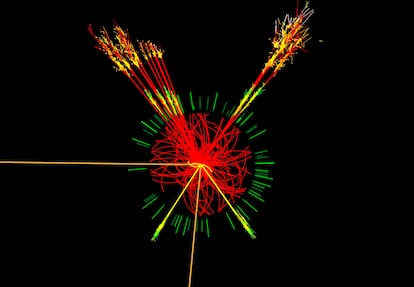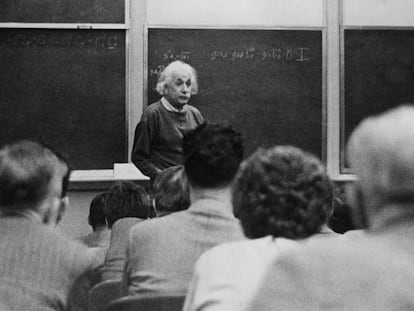Results from particle accelerator hint at ‘new mechanism in nature’
According to a study, the W boson does not obey the rules of the most accepted theory of quantum materials. While the findings are yet to be confirmed, they are already reactivating ‘the search to try to explain unknown phenomena’

One of the world’s biggest particle accelerators has produced a troubling result: the mass of the W boson – a fundamental particle that is crucial for our understanding of matter and the universe – is not what it should be.
If these results are confirmed, “it has to be because there is a new mechanism in nature that we are not aware of,” explains Ashutosh Kotwal, a researcher from Duke University in the United States and the leader of the study. This mechanism “could manifest itself in the form of a particle or an interaction inside the atomic nucleus that we may discover in future experiments,” he adds. Hundreds of researchers have participated in the work, which involved the 12 different countries that contribute to the CDF II experiment, at the Tevatron particle accelerator in the United States.
To understand the importance of this discovery, we have to travel to the quantum level of matter: penetrating the microscopic atoms that make up every one of the letters of this text and reaching their most-basic components, the elementary particles. Everything that humans can see and touch is made up of different combinations of 17 elemental particles, which fall into three major categories: quarks, leptons and bosons. Three quarks together form a proton, and if we add a lepton we obtain the simplest element in the universe, hydrogen. Uranium, one of the most complex elements, has more than 700 quarks of different types and 92 leptons.
In the 1970s, the standard model was defined, setting out the properties of these 17 pieces of the puzzle that form the atoms of all of the known elements. According to this model, quarks and leptons constitute the matter and the bosons transmit the known forces, such as electromagnetism. For decades now, human beings have been building ever-more-powerful particle accelerators to smash up atoms into their different elemental particles and to test whether they follow the rules of the game. The results published today show that at least one of these 17 parts does not obey the rules.
Between 2002 and 2011, the Tevatron was firing protons into their antiparticle, the antiproton. This subatomic particle has the same mass as a proton but with a negative charge. The particles travel close to the speed of light and when they collide, they disintegrate into other elementary particles. After analyzing more than four million boson W particles, the researchers found that its mass is 80,433 megaelectronvolts, while the standard model predicted 80,357, with a margin of error included in both of them. The difference is outside the theoretical framework.
The most plausible interpretation is that supersymmetry really exists, which implies that there are known particles that have unknown supersymmetric sistersSven Heinemeyer, researcher from the Institute of Theoretical Physics in Madrid
There are only three possibilities in a trillion that this result could be chance. In the jargon of physicists, this is known as seven sigma: a discovery in particle physics is accepted with a level of error of one in a million.
“This new measure of the mass of the W is the most precise and complete that has been done until now,” explains Alberto Ruiz, a researcher at the Cantabria Physics Institute and one of the authors of the study, which has been published in Science magazine. “They are spectacular results.”
Until now the standard model had perfectly described the behavior of conventional matter. The problem is that this kind of matter only makes up 5% of the universe. The rest of the cosmos is dark matter (27%) and dark energy (68%), which are completely unknown. These results may be the first glimpses of the “new physics”: unknown particles that help to explain these great mysteries of the universe.
The experiments in two of the particle accelerators at the European Organization for Nuclear Research (CERN) had produced values that were in line with the theory. But last year, another Tevatron experiment also found discrepancies with the behavior of the muon, another elementary particle.
The Tevatron ceased to operate in 2011. Now the wait will begin for the heads of the Large Hadron Collider (LHC) at CERN to revise the data they have collected and confirm or disprove that this boson is not exactly how it should be. This process could take up to a year of analysis, in Ruiz’s opinion.
“This is the biggest discrepancy that has been described between the theory and the experimental results if we take into account the level of accuracy, which is of seven sigma,” admits Sven Heinemeyer, a researcher from the Institute of Theoretical Physics in Madrid, Spain. Heinemeyer is a theoretical physicist in charge of studying the real mass of the W boson and coming up with new theories to explain it. “The most plausible interpretation is that supersymmetry really exists, which implies that there are known particles that have unknown supersymmetric sisters,” he argues. Among these particles are those that make up dark matter. “The most interesting thing,” Heinemeyer adds, “is that the new supersymmetric particles would not have much mass, meaning that it is possible that the LHC could discover them. It’s very surprising,” he adds.
Mario Martínez, a researcher from the High Energy Physics Institute in Barcelona, worked at the Tevatron for years and now is taking part in the LHC’s Atlas experiment, which is among those that will confirm or refute these results. “This is a very important measure that requires a huge amount of precision, which explains why it has taken more than 10 years to publish it,” he explains. “For now I would recommend caution. The previous measures did coincide with the theory, which means that there could be some kind of calibration error with the instrument in the US. We will have to wait for confirmation with the LHC.”
What is already certain is that these results open a new field of work, according to Ruiz. “After the discovery of the Higgs,” he says, in reference to the identification of the last of the 17 elementary particles in 2012, “the field was somewhat paralyzed and this reactivates the search to try to explain unknown phenomena.”
Tu suscripción se está usando en otro dispositivo
¿Quieres añadir otro usuario a tu suscripción?
Si continúas leyendo en este dispositivo, no se podrá leer en el otro.
FlechaTu suscripción se está usando en otro dispositivo y solo puedes acceder a EL PAÍS desde un dispositivo a la vez.
Si quieres compartir tu cuenta, cambia tu suscripción a la modalidad Premium, así podrás añadir otro usuario. Cada uno accederá con su propia cuenta de email, lo que os permitirá personalizar vuestra experiencia en EL PAÍS.
¿Tienes una suscripción de empresa? Accede aquí para contratar más cuentas.
En el caso de no saber quién está usando tu cuenta, te recomendamos cambiar tu contraseña aquí.
Si decides continuar compartiendo tu cuenta, este mensaje se mostrará en tu dispositivo y en el de la otra persona que está usando tu cuenta de forma indefinida, afectando a tu experiencia de lectura. Puedes consultar aquí los términos y condiciones de la suscripción digital.
More information
Últimas noticias
Aquilino Gonell, former Capitol sergeant: ‘If it hadn’t been for the police, the US would be a dictatorship’
A hybrid building: Soccer pitch, housing, and a shopping mall
Europe urges Trump to respect Greenland following annexation threats
Science seeks keys to human longevity in the genetic mixing of Brazilian supercentenarians
Most viewed
- Alain Aspect, Nobel laureate in physics: ‘Einstein was so smart that he would have had to recognize quantum entanglement’
- Mexico’s missing people crisis casts a shadow over World Cup venue
- Why oil has been at the center of Venezuela-US conflicts for decades
- Alvin Hellerstein, a 92-year-old judge appointed by Bill Clinton, to preside over Maduro’s trial in New York
- Cuba confirms death of 32 of its citizens in the US attack against Venezuela











































